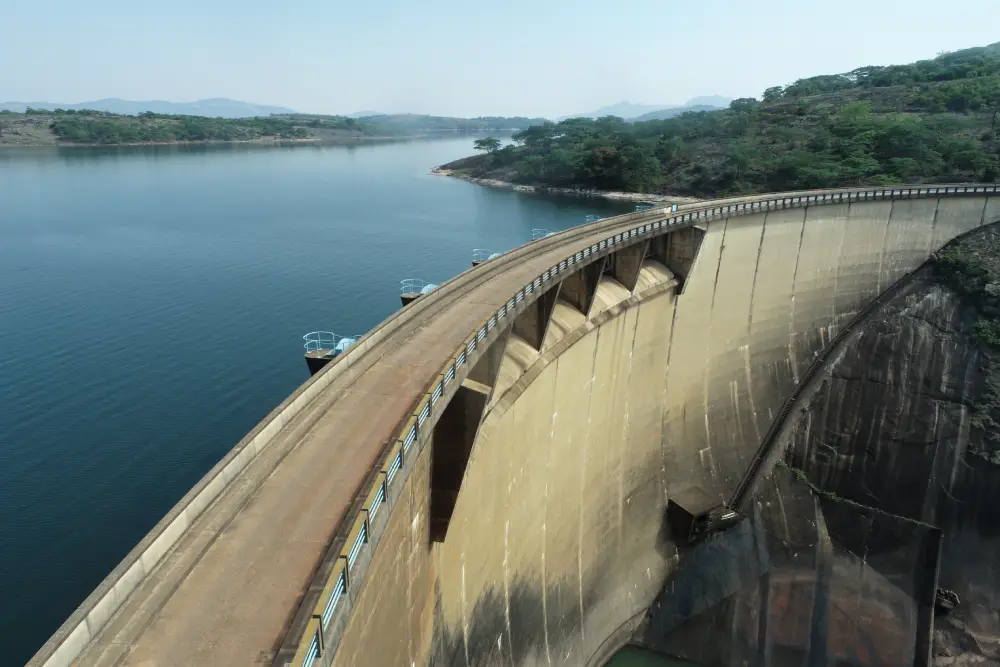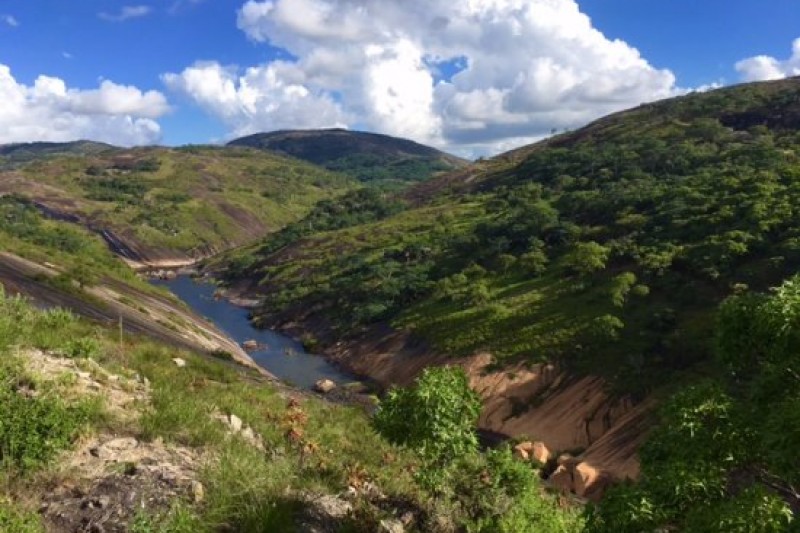Lake Mutirikwi, located in southeastern Zimbabwe, is a man-made reservoir that stands as a testament to human engineering and environmental impact.
This expansive lake, also known as Lake Kyle, serves multiple purposes, including irrigation, hydroelectric power generation, and providing recreational opportunities.
Its shores bear witness to a rich history and diverse activities that make it a significant landmark in the region.
ALSO READ: https://zimprofiles.com/discovering-mavuradonha-wilderness-area-zimbabwes-pristine-haven/

Lake Mutirikwi. Picture credit to Zim bhoo
Origin of the Name
The name “Mutirikwi” has its roots in the local Shona language, translating to “pool of the chiefs.”
This nomenclature reflects the historical and cultural significance attached to the lake in the context of the local community.
The origin of the name “Mutirikwi” depends on what you’re referring to. Here are two possibilities:
1. Lake Mutirikwi:
- Originally known as Lake Kyle or Kyle Dam, named after Kyle Farm, which occupied most of the land required for the lake.
- Kyle Farm itself was named after the Kyle district in Scotland, where the pioneer of the Lowveld, Tom Murray MacDougall, came from.
- In 1983, after Zimbabwe’s independence, the lake was renamed Mutirikwi, which is a Shona word meaning “place of many wild fruits”. This name reflects the abundance of fruit trees that historically grew in the area.
2. The name “Mutirikwi” in general:
- “Mutirikwi” is a Shona word, but its meaning can vary depending on context.
- It could refer to a specific type of tree, a place name, or even a family name.
- Without more information, it’s difficult to pinpoint the exact origin of the name in this context.
Additional information:
- Since you’re currently in Harare, Zimbabwe, it’s most likely you’re referring to Lake Mutirikwi.
ALSO READ: https://zimprofiles.com/exploring-manyame-dam-recreational-park-a-comprehensive-guide/
History of the Place
Constructed in the 1960s, Lake Mutirikwi is the result of the ambitious Kyle Dam project.
The dam’s construction aimed to address water supply needs, facilitate agriculture through irrigation, and generate hydroelectric power.
Over the years, Lake Mutirikwi has become an integral part of the region’s development and lifestyle.
Lake Mutirikwi, formerly known as Lake Kyle or Kyle Dam, boasts a rich history interwoven with agriculture, changing landscapes, and even a touch of controversy. Here’s a look at its journey:
Early Days (Pre-1960):
- The land where the lake now sits was once occupied by various Shona communities, who likely called it by names reflecting its natural features.
- In the 1890s, colonial land appropriation led to the establishment of large farms in the area, including Kyle Farm owned by Tom Murray MacDougall.
Construction and Purpose (1958-1960):
- With increasing agricultural demands, particularly for irrigation in the Lowveld’s sugar estates, the Kyle Dam project was initiated in 1958.
- Built on the Mutirikwi River, the double-curvature concrete arch dam wall was completed in 1960, creating the second-largest lake in Zimbabwe.
- Initially named after Kyle Farm, the lake served as a critical irrigation source for the Lowveld, boosting sugarcane production.
- Kyle Recreational Park was established on the northern shore, becoming a popular tourist destination.
Post-Independence and Re-imagining (1980s onwards):
- Following Zimbabwe’s independence in 1980, the lake was renamed Mutirikwi, reflecting the Shona heritage and acknowledging the pre-colonial landscape.
- However, water allocation remained focused on Lowveld irrigation, leading to fluctuations in the lake’s level and tensions with local communities who desired a more balanced approach.
- The 1980s drought significantly impacted the lake’s level, highlighting the need for better water management and diversification.
- Issues like upstream deforestation and siltation added to the challenges faced by the lake’s ecosystem.
Present Day and Looking Forward:
- While still a vital irrigation source, Lake Mutirikwi faces ongoing challenges with water security and ecological balance.
- Efforts are underway to promote sustainable farming practices, improve catchment management, and explore alternative water sources.
- The lake remains a crucial resource for the region, balancing agricultural needs with ecological sustainability and community aspirations.
Additionally:
- St. Andrew’s Chapel, a tiny Gothic structure built by a grieving father in memory of his daughter, stands near the dam wall, adding a unique human touch to the lake’s story.
- The historical renaming from Kyle to Mutirikwi symbolizes the ongoing struggle for cultural recognition and resource control in post-colonial Zimbabwe.
ALSO READ: https://zimprofiles.com/historic-tours-and-adrenaline-rush-experiencing-victoria-falls-bridge/

Lake Mutirikwi: Picture credit to Fambayi
Geographical Location
Situated in the Masvingo Province, Lake Mutirikwi sprawls across the landscape, offering picturesque views of the surrounding hills and plains.
Its strategic location has contributed to its role as a vital resource for agriculture, power generation, and recreation.
- It is located in southern Zimbabwe, southeast of Masvingo.
- The coordinates of the lake are 20°14′56.12″S 31°01′59.74″E (or 20.2489222°S 31.0332611°E).
Activities to Do
Lake Mutirikwi, formerly known as Lake Kyle, offers a variety of activities for visitors seeking adventure, relaxation, or something in between. Here are some ideas to get you started:
Wildlife Exploration:
Game Drives: Embark on a self-guided game drive in your own vehicle and keep your eyes peeled for diverse wildlife like rhinos, zebras, giraffes, kudus, and impalas. Remember, there are no predators or elephants in the park, making it a safe environment for observing animals.
Horseback Riding: Explore the park’s scenic landscapes and get closer to the animals on a guided horseback safari. Experienced riders can even embark on longer overnight treks.
Birdwatching: With over 300 recorded bird species, Lake Mutirikwi is a paradise for bird enthusiasts. Keep an eye out for colourful weavers, majestic eagles, and elusive owls.
Water Activities:
- Boating: Enjoy a leisurely boat ride on the lake, soaking in the scenic beauty and spotting wildlife from a different perspective. You can bring your own boat or rent one from local operators.
- Fishing: Cast your line for various fish species like bream, tigerfish, and barbel. Remember to obtain a fishing permit beforehand and be aware of safety regulations.
- Swimming: Take a refreshing dip in the designated swimming areas, but be cautious of crocodiles and bilharzia (schistosomiasis).
Relaxation and Recreation:
- Picnics: Pack a delicious picnic basket and find a scenic spot by the lake for a relaxing meal with family or friends. Designated picnic areas are available with tables and braai stands.
- Hiking: Explore the park’s diverse terrain on marked hiking trails, ranging from easy walks to challenging climbs. Enjoy the panoramic views and the opportunity to spot wildlife along the way.
- Camping: Pitch your tent at designated campsites and spend the night under the stars. Enjoy the peacefulness of nature and the sounds of the lake.
Cultural Immersion:
- Visit the Great Zimbabwe Ruins: Just a short drive from the lake lies the UNESCO World Heritage Site of Great Zimbabwe, an impressive stone complex dating back to the 11th century.
- Learn about Shona Culture: Connect with the local Shona community and learn about their traditions, crafts, and way of life.
Important Reminders:
- Always prioritize safety and follow park regulations.
- Be mindful of the presence of crocodiles and bilharzia, especially near the water.
- Respect the environment and leave no trace of your visit.
- Pack essential supplies like sunscreen, insect repellent, and enough water.
Police Contacts
For emergencies or security concerns within the Lake Mutirikwi area, visitors can contact the local authorities:
Emergency Contact: []

Lake Mutirikwi: picture credit to WowZimbabwe
Council Contacts
For inquiries about regulations, permits, and general information, visitors can contact the local council office:
Council Office: []
References
- Zimbabwe National Water Authority: Lake Mutirikwi – Zimbabwe National Water Authority, Date Published: [Insert Date]
- Masvingo Tourism Board: Exploring Lake Mutirikwi – Masvingo Tourism Board, Date Published: [Insert Date]
- Engineering Marvels: The Kyle Dam Project – Engineering Gazette, Date Published: [Insert Date]
- Angler’s Paradise: Fishing Tales from Lake Mutirikwi – Fishing Today Magazine, Date Published: [Insert Date]



